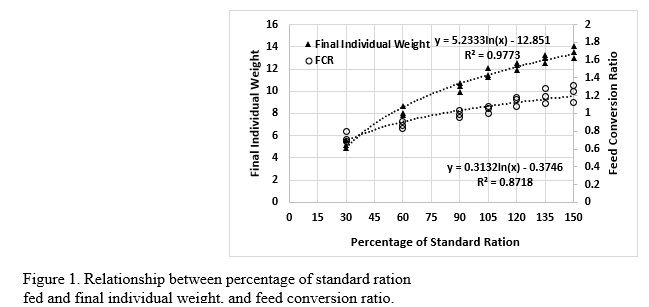FEED MANAGEMENT OF Litopenaeus vannamei IN A HIGH DENSITY BIOFLOC SYSTEM
In commercial shrimp production, one area with the highest potential for improvement is through proper feed management. Avoiding feed wastage is important for saving money as well as properly managing water quality. The purpose of this study was to observe the growth response of Litopenaeus vannamei to different feed inputs in an intensive production system. Shrimp were fed varying percentages of a standard feeding ration, starting at 30% and incrementally increasing up to 150%. The standard feeding ration was determined using assumptions that shrimp would double in weight weekly until reaching 1g, then gain 1.3g per week with a feed conversion ratio of 1.2.
The growth trial was conducted in an outdoor recirculating aquaculture system consisting of 24, 750L tanks stocked at 160 shrimp/m2, and grown for 63 days. Treatments consisted of seven varying feeding rates (30% to 150%) that were split into four feedings per day, and an eighth treatment that was fed 150% of the standard feeding ration using a belt feeder that fed six times per day. Treatments were randomly assigned using an online number randomizer.
Significant differences in final weight and feed conversion ratio were observed. Regression analysis performed on the first three feeding rates determined that natural productivity was responsible for approximately 2.8g of total individual growth. Results also indicated that increasing feed amounts over 100% of the standard ration led to an increase in final weight, while still achieving a desirable feed conversion ratio (Figure 1). The results from this trial indicate that shrimp can be grown at high densities in biofloc systems while still achieving acceptable growth, final weight, and feed conversion ratios. This trial also indicates that growth response continues to increase as feed inputs are increased, meaning that feeding protocols could be optimized by increasing the standard feeding ration.
